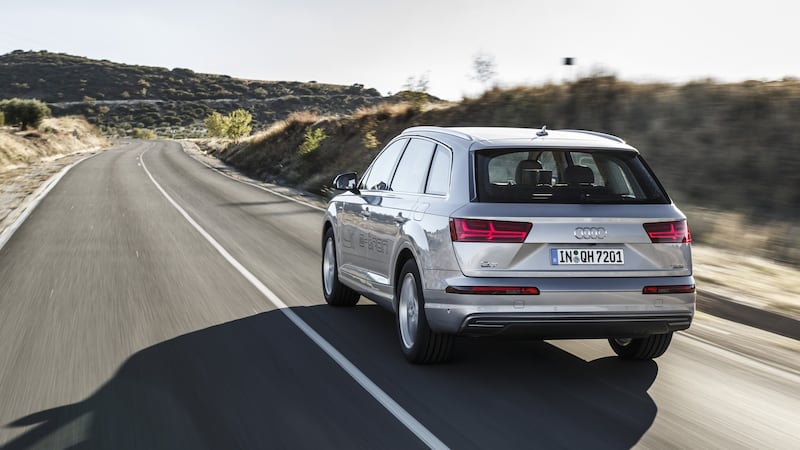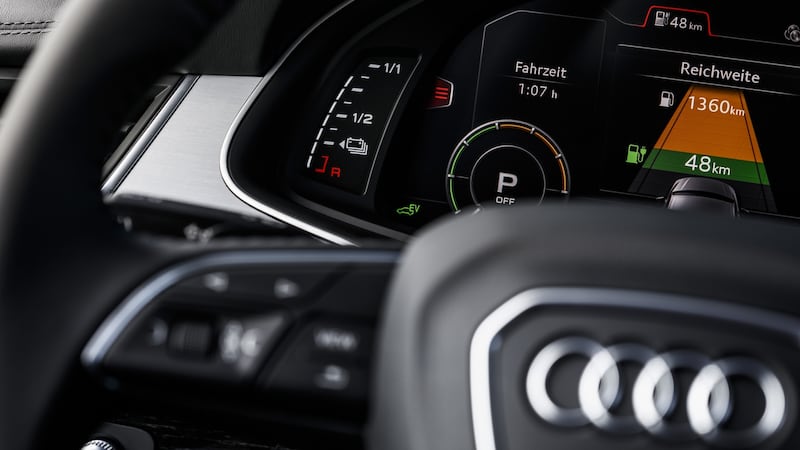Somewhere in the first quarter of next year the first Audi Q7 e-tron might come stealthily rolling past you. Or it might not. It might come with its 3.0-litre V6 TDI on full noise. Or it might come midway through a six-second sprint to 100km/h.
It might be doing any of those things because the Q7 e-tron will be a machine of many talents and extreme versatility, and it will be a machine that asks few compromises of its owners, save the installation of a fast charger at home and the loss of a bit of underfloor space in the luggage area.
This is a machine that can run with no local emissions, turning the big SUV into a battery-electric car for up to 56km. It can run as a pure V6 turbodiesel, with 600Nm of torque, or it can run with both the diesel and the electric motors lit up, pushing that out to 700Nm of system output.


It can do it seamlessly, too, swinging each motor in and out of the powertrain so smoothly that all you notice is the change in noise.
You can even leave it to its own devices and then based on your proposed route, its ultra-clever satnav will figure out where you’ll need diesel power, where you’ll need electric power and everything in between.
It will even pre-emptively switch to battery power as you run through small towns on the way, to help reduce pollutants in urban areas as it goes. (And, let’s face it: the Volkswagen Group owes us at least a bit of that.)
The short version of the Q7 e-tron looks like this: it’s still based around the Q7’s MLB Evo architecture, so the V6 engine sits longitudinally in the engine bay, fed from a 75-litre fuel tank and driving all four wheels through an eight-speed automatic transmission. Simple so far.
Then the radical bits come in. The standard Q7’s eight-speeder is turfed for a different one, with a 94kW/350Nm electric motor sitting between it and the diesel engine. The water-cooled battery pack sits in a solid aluminium shell above the multi-link independent rear suspension. And it’s a sizeable thing.
It is, by itself, 202kg, with 168 prismatic cells stuffed into 14 modules and delivering 17.3kWh of energy, rated to 308 volts.
According to the official, but tainted, New European Drive Cycle (NEDC) test figures, it’s good enough to give the Audi 56km of electric running or 1,400km of total range, with consumption of 1.7 litres/100km. It will charge completely in two-and-a-half hours from an industrial outlet.
Real-world test
Now, as Nissan’s Leaf has proven, the NEDC isn’t the best real-world test of electrically powered machinery, but there will be people who can live on pure electric power for weeks at a time and there will be people who can’t.
Another clever bit, and one for which Audi is claiming a world-first for plug-ins, is a heat pump that takes excess heat away from the electrical systems and diverts it to heat the cabin and ancillaries, saving power.
The other huge step forward is Audi’s Navigation Plus. In combination with the on-board wifi hotspot, it mulls over your entered destination and uses real-time traffic information to calculate when to switch from diesel to hybrid to pure-electric running. It’s almost magnificently clever.
The entire idea of driving a plug-in hybrid is, effectively, to arrive at your destination with a flat battery. That’s the most efficient way to drive and the battery is also cheaper to refill than the diesel tank.
So that’s what this predictive technology tries to do, and largely does, when drivers don’t get in the way by intervening.
The car always starts in hybrid mode, which means it begins each journey as a pure electric car. Which means you know it’s on because you pushed “Start” and some lights came on.
Then you pull the gear lever into drive and off you go, noiselessly, into the traffic.
There’s no need to be concerned about its abilities as an electric car, because 350Nm of torque is not insignificant. It’s also instant, so there’s no waiting for the punch. The punch is always there, whenever you ask for it.
In some ways, at low speed, it’s stronger. It surges off the line at speeds where a diesel engine’s turbocharger is still waking up. Kick down on the accelerator pedal and the diesel engine chimes right in, waking up with just a bit of noise but barely a trace of any vibration. Push through it hard and the Q7 gets up and boogies pretty well, with 700Nm of combined outputs from both engines enough to encourage the big rig to hustle along impressively.
Impeccable
The ride is also impeccable, with the biggest laurel going to the guys who tracked down every trace of wind noise and road noise and killed it, save for a bit of rear-tyre roar on coarser, chipped roads. Even with the diesel engine running, it’s quieter than the A8 limousine.
It’s not all great, though. In the real world, one with corners and things, there is one number that stands out: 2,445. That’s how many kilograms the Q7 e-tron weighs and it’s an unshakeable number. The standard Q7 3.0-litre TDI is 2,135kg. Where the standard version combines body control with steering accuracy and immaculate ride, the e-tron suffers.
Audi fitted all of its test cars with the optional adaptive damping system, but even that couldn’t always keep the mass under control on quick direction changes or long corners.
Not to the point of danger, just discomfort and obvious effort, which you just don’t get in the standard cars.
It doesn’t lack for sophistication, but when you lower the internal combustion just a tad and make a point of how much better that makes the handling, then you stick 200kg of battery pack above the rear axle, it’s not dynamically possible to keep everything working the same way.
Dynamic mode
Added to the battery are the power electronics, the water-cooling system, the heat exchanger, the electric motor and the extra cables. Then there is a 24-litre AdBlue tank (for urea, which might have solved a lot of Audi’s current PR and legislative problems had it been fitted to everything), plus bigger brakes and stronger axles.
It’s better in its dynamic mode, when the suspension and steering stiffen up and help the car through the bends more, plus the electro-mechanical steering feels more intuitively accurate in the sportier mode all the time. Fortunately, you can mix and match them with an individual setting.
While nothing has been confirmed for Ireland yet, we suspect pricing will be at the upper end of the range, which tops out at more than €90,000 for the best-equipped Q7 3-litre TDI, but the performance is there when you need it and in the wake of the Dieselgate scandal, surely this, and not ever more powerful turbodiesel engines, is where large SUVs need to go to be sustainable.
It’s significantly imperfect, largely due to its weight, and the spotlight shines brighter on that imperfection because of the brilliance of the standard Q7 fare.
However, for a lot of people – people commuting around 25km each way, for example – it will be exactly, perfectly, right.
